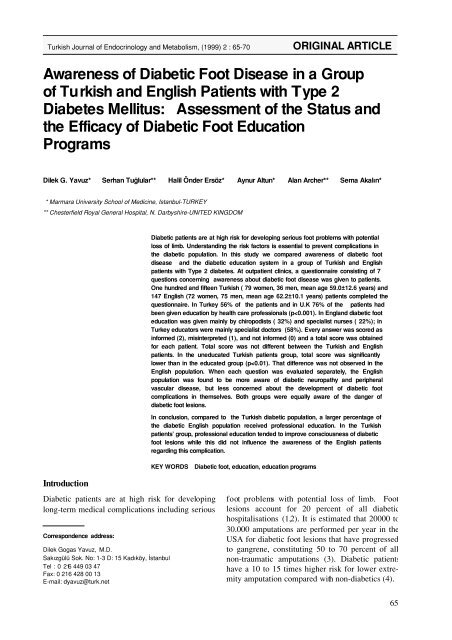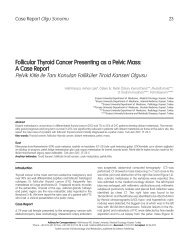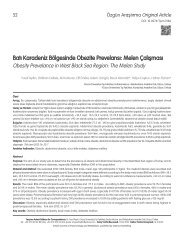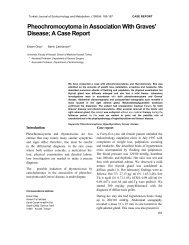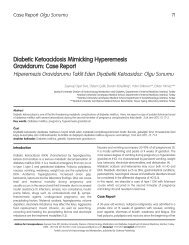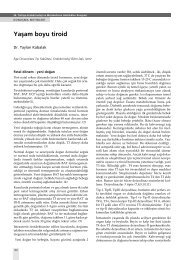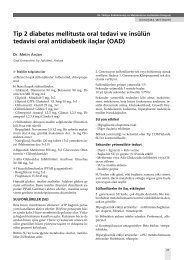Awareness of Diabetic Foot Disease in a Group - Turkish Journal of ...
Awareness of Diabetic Foot Disease in a Group - Turkish Journal of ...
Awareness of Diabetic Foot Disease in a Group - Turkish Journal of ...
You also want an ePaper? Increase the reach of your titles
YUMPU automatically turns print PDFs into web optimized ePapers that Google loves.
<strong>Turkish</strong> <strong>Journal</strong> <strong>of</strong> Endocr<strong>in</strong>ology and Metabolism, (1999) 2 : 65-70 ORIGINAL ARTICLE<br />
<strong>Awareness</strong> <strong>of</strong> <strong>Diabetic</strong> <strong>Foot</strong> <strong>Disease</strong> <strong>in</strong> a <strong>Group</strong><br />
<strong>of</strong> <strong>Turkish</strong> and English Patients with Type 2<br />
Diabetes Mellitus: Assessment <strong>of</strong> the Status and<br />
the Efficacy <strong>of</strong> <strong>Diabetic</strong> <strong>Foot</strong> Education<br />
Programs<br />
Dilek G. Yavuz* Serhan Tu¤lular** Halil Önder Ersöz* Aynur Altun* Alan Archer** Sema Akal›n*<br />
* Marmara University School <strong>of</strong> Medic<strong>in</strong>e, Istanbul-TURKEY<br />
** Chesterfield Royal General Hospital, N. Darbyshire-UNITED KINGDOM<br />
Introduction<br />
<strong>Diabetic</strong> patients are at high risk for develop<strong>in</strong>g<br />
long-term medical complications <strong>in</strong>clud<strong>in</strong>g serious<br />
Correspondence address:<br />
Dilek Gogas Yavuz, M.D.<br />
Sak›zgülü Sok. No: 1-3 D: 15 Kad›köy, ‹stanbul<br />
Tel : 0 216 449 03 47<br />
Fax: 0 216 428 00 13<br />
E-mail: dyavuz@turk.net<br />
<strong>Diabetic</strong> patients are at high risk for develop<strong>in</strong>g serious foot problems with potential<br />
loss <strong>of</strong> limb. Understand<strong>in</strong>g the risk factors is essential to prevent complications <strong>in</strong><br />
the diabetic population. In this study we compared awareness <strong>of</strong> diabetic foot<br />
disease and the diabetic education system <strong>in</strong> a group <strong>of</strong> <strong>Turkish</strong> and English<br />
patients with Type 2 diabetes. At outpatient cl<strong>in</strong>ics, a questionnaire consist<strong>in</strong>g <strong>of</strong> 7<br />
questions concern<strong>in</strong>g awareness about diabetic foot disease was given to patients.<br />
One hundred and fifteen <strong>Turkish</strong> ( 79 women, 36 men, mean age 59.0±12.6 years) and<br />
147 English (72 women, 75 men, mean age 62.2±10.1 years) patients completed the<br />
questionnaire. In Turkey 56% <strong>of</strong> the patients and <strong>in</strong> U.K 76% <strong>of</strong> the patients had<br />
been given education by health care pr<strong>of</strong>essionals (p
ORIGINAL ARTICLE<br />
There is a marked correlation between the level <strong>of</strong><br />
the patient is understand<strong>in</strong>g <strong>of</strong> the disease and the<br />
development <strong>of</strong> the foot lesions (5). The effectiveness<br />
<strong>of</strong> frequent foot exam<strong>in</strong>ation among patients<br />
coupled with <strong>in</strong>tensive patient education was<br />
shown to br<strong>in</strong>g about a susta<strong>in</strong>ed decrease <strong>of</strong><br />
nearly 50 percent <strong>in</strong> the amputation rate (6) and to<br />
significantly lower the rate <strong>of</strong> hospital admissions<br />
for diabetic foot complications (7). Education <strong>of</strong><br />
the <strong>in</strong>dividual patient regard<strong>in</strong>g the methods <strong>of</strong><br />
foot care and awareness <strong>of</strong> diabetic foot problems<br />
is the ma<strong>in</strong>stay <strong>of</strong> the prevention <strong>of</strong> this devastat<strong>in</strong>g<br />
complication (8-11).<br />
At our diabetes outpatient cl<strong>in</strong>ics, we rout<strong>in</strong>ely<br />
perform foot exam<strong>in</strong>ations and give patient education<br />
to groups and/or on an <strong>in</strong>dividual basis. In this<br />
study, we aimed to assess the educational status <strong>of</strong><br />
our patients on this issue and the effect <strong>of</strong> diabetes<br />
education on the awareness <strong>of</strong> diabetic foot<br />
disease. We compared the results with<strong>in</strong> our own<br />
population and with a group <strong>of</strong> English Type 2<br />
diabetic patients <strong>in</strong> order to evaluate the status and<br />
efficacy <strong>of</strong> diabetes education programs.<br />
Materials and Methods<br />
At our outpatient cl<strong>in</strong>ics, patients who had an<br />
established diagnosis <strong>of</strong> type 2 diabetes mellitus,<br />
were asked to fill <strong>in</strong> a questionnaire regard<strong>in</strong>g their<br />
state <strong>of</strong> diabetic education and awareness <strong>of</strong><br />
diabetic foot problems. Patients who had had a<br />
diabetic foot lesion before were not <strong>in</strong>cluded <strong>in</strong> the<br />
study.<br />
The questionnaire had two ma<strong>in</strong> sections. The first<br />
section consisted <strong>of</strong> questions regard<strong>in</strong>g the demographic<br />
data <strong>of</strong> the patient <strong>in</strong>clud<strong>in</strong>g age, gender,<br />
duration <strong>of</strong> diabetes, occupation and education.<br />
The patients were also questioned about the state<br />
<strong>of</strong> diabetic education, whether they had been given<br />
any lectures or recommendations about diabetic<br />
foot problems and personal foot care. The patients<br />
who had had a pr<strong>of</strong>essional based education were<br />
asked to <strong>in</strong>dicate the source <strong>of</strong> education as a specialist<br />
doctor (<strong>in</strong>ternist or diabetologist), general<br />
practitioner, specialist nurse, dietician, or chiropodist.<br />
The second section consisted <strong>of</strong> 7 questions<br />
regard<strong>in</strong>g awareness <strong>of</strong> diabetic foot disease (Table<br />
66<br />
1), about the probability <strong>of</strong> develop<strong>in</strong>g peripheral<br />
vascular disease and diabetic neuropathy, the<br />
relation between these disorders and diabetic foot<br />
ulcers or gangrene, estimat<strong>in</strong>g their personal risk<br />
<strong>in</strong> these situations, and the importance <strong>of</strong> diabetic<br />
foot lesions.<br />
Table 1. Questionnaire conta<strong>in</strong><strong>in</strong>g 7 questions which require answers<br />
rat<strong>in</strong>g the importance possibility <strong>of</strong> the follow<strong>in</strong>g situations<br />
from 0 to 6.<br />
1. Is it true that all patients with diabetes develop reduced blood<br />
flow <strong>in</strong> their feet?<br />
2. Is it true that all patients with diabetes develop lack <strong>of</strong> feel<strong>in</strong>g <strong>in</strong><br />
their feet?<br />
3. Is it true that all patients with diabetes develop foot ulcers?<br />
4. Is it true that all patients with diabetes develop gangrene?<br />
5. Imag<strong>in</strong>e that you have a lack <strong>of</strong> feel<strong>in</strong>g <strong>in</strong> your feet. How likely is<br />
it that you will develop a foot ulcer?<br />
6. Imag<strong>in</strong>e that you have reduced blood flow <strong>in</strong> your feet. How<br />
likely is it that you will develop a foot ulcer?<br />
7. Imag<strong>in</strong>e that you have a foot ulcer with <strong>in</strong>fection. How dangerous<br />
do you th<strong>in</strong>k this situation would be?<br />
Each question consisted <strong>of</strong> 6 different scores<br />
rang<strong>in</strong>g from "never heard" to "not important",<br />
"important", or" very serious". Answers for each<br />
question were scored between 0 to 2 <strong>in</strong> order to<br />
assess a total score, 0 for not be<strong>in</strong>g <strong>in</strong>formed, 1 for<br />
wrong <strong>in</strong>formation (either underestimation or overestimation<br />
<strong>of</strong> the importance <strong>of</strong> the disease), and 2<br />
for correct <strong>in</strong>formation.<br />
Statistical analysis was performed with an IBM<br />
compatible PC by Instat II program. Total scores<br />
<strong>of</strong> the patient groups were compared by Mann<br />
Whitney-U test and subgroup scores by Kruskal<br />
Wallis ANOVA test. Scores for each question<br />
were compared by chi-square test.<br />
Results<br />
The study was performed <strong>in</strong> a group <strong>of</strong> <strong>Turkish</strong><br />
and English type 2 diabetic patients. One hundred<br />
and fifteen <strong>Turkish</strong> (79 women, 36 men, mean age<br />
59.0±12.6 years) and 147 English (72 women, 75<br />
men, mean age 62.2±10.1 years) patients completed<br />
the questionnaires.<br />
In the <strong>Turkish</strong> group (T) 64 <strong>of</strong> 115 patients (56 %)<br />
had had pr<strong>of</strong>essional diabetic foot education, while
<strong>in</strong> the English patients’ group (E) this was 112 <strong>of</strong><br />
147 (76%), be<strong>in</strong>g significantly higher than the T<br />
group (p
The fifth and the sixth questions were asked to<br />
patients <strong>in</strong> order to make them estimate their own<br />
risk <strong>in</strong> these situations. In the T group 20.9% were<br />
unaware <strong>of</strong> the risk for the development <strong>of</strong> foot<br />
ulcer if they had a lack <strong>of</strong> sensation <strong>in</strong> their feet,<br />
while this was only 8.2% <strong>in</strong> the E group. But<br />
36.7% <strong>of</strong> the E group underestimated the risk and<br />
scored this question as unimportant while this was<br />
only 11.3% <strong>in</strong> the T-group. As a result total score<br />
was higher <strong>in</strong> the T group, with 67.8% <strong>of</strong> the patients<br />
hav<strong>in</strong>g adequate <strong>in</strong>formation while this was<br />
only 55.1% <strong>in</strong> the E group (p
expla<strong>in</strong>ed by the <strong>in</strong>dividual analyses <strong>of</strong> questions.<br />
<strong>Turkish</strong> patients were less aware about the mechanisms<br />
lead<strong>in</strong>g to diabetic foot problems compared<br />
with English patients. A very important part <strong>of</strong> the<br />
group had never heard <strong>of</strong> neuropathy or peripheral<br />
vascular disease, but they were aware <strong>of</strong> the probable<br />
results: diabetic foot ulcers and gangrene.<br />
On an <strong>in</strong>dividual basis, English patients underestimated<br />
their own risk for these complications<br />
while <strong>Turkish</strong> patients tended to overestimate.<br />
Aga<strong>in</strong> this may be a result <strong>of</strong> the source <strong>of</strong> education.<br />
Doctors usually have less time for such an<br />
educational practice and <strong>in</strong> lectures they sometimes<br />
are direct and perhaps frighten<strong>in</strong>g <strong>in</strong>stead <strong>of</strong> be<strong>in</strong>g<br />
comprehensive and supportive. This result <strong>in</strong>dicates<br />
that the ma<strong>in</strong> educator <strong>in</strong> foot problems should be<br />
a specialist such as a chiropodist and may be a<br />
specialist nurse.<br />
Another result <strong>of</strong> this study is the lack <strong>of</strong> difference<br />
between educated and uneducated English<br />
patients. Educated <strong>Turkish</strong> patients had a higher<br />
total score and higher scores for many <strong>of</strong> the questions<br />
compared with the uneducated group as we<br />
had expected. But neither the total score nor any <strong>of</strong><br />
the scores for <strong>in</strong>dividual questions were different<br />
between educated and uneducated English patients.<br />
The higher educational level <strong>of</strong> the English<br />
population regard<strong>in</strong>g health problems may expla<strong>in</strong><br />
this. In Turkey, public education programs about<br />
general health care and special medical problems<br />
are very limited.<br />
Simple efforts on the part <strong>of</strong> health care providers<br />
and patients can reduce the risk <strong>of</strong> diabetic foot<br />
disease (7). But most <strong>of</strong> these simple procedures<br />
are not be<strong>in</strong>g systematically applied by health care<br />
providers or patients (12). Most <strong>of</strong> the diabetic<br />
patients do not rout<strong>in</strong>ely perform simple foot care<br />
assessments (13). They may not be aware <strong>of</strong> foot<br />
care procedures or how to do them, or they may<br />
not believe that such procedures can make a difference<br />
(14). The level <strong>of</strong> the patient’s understand<strong>in</strong>g<br />
<strong>of</strong> the disease and the likelihood <strong>of</strong> the development<br />
<strong>of</strong> diabetic foot lesions are <strong>in</strong>versely correlated<br />
(questions 5,6,7) (5). On an <strong>in</strong>dividual basis,<br />
every diabetic patient needs to be <strong>in</strong>formed about<br />
the causes, nature, and outcome <strong>of</strong> diabetic foot<br />
disease and about preventive self foot care measures.<br />
They have to believe <strong>in</strong> what they do and<br />
should be encouraged by health care providers to<br />
cont<strong>in</strong>ue.<br />
In this study we assessed the educational status<br />
and awareness <strong>of</strong> our patient population and compared<br />
it with a group <strong>of</strong> English diabetic patients.<br />
Although a smaller percentage <strong>of</strong> our group had a<br />
pr<strong>of</strong>essional based education, the total score was<br />
not different from the English patients. In our<br />
study population, pr<strong>of</strong>essional education improved<br />
the consciousness <strong>of</strong> diabetic foot disease while<br />
the awareness <strong>of</strong> the English patients regard<strong>in</strong>g<br />
this problem did not <strong>in</strong>crease after further education.<br />
Our study showed once aga<strong>in</strong> that the more knowledge<br />
the fewer complications. Educated diabetic<br />
patients develop fewer diabetic foot complications.<br />
That is why we should <strong>in</strong>clude and <strong>in</strong>sist on a foot<br />
care program <strong>in</strong> diabetic education programs. A<br />
Chiropodist can be the ma<strong>in</strong> educator about<br />
diabetic foot care.<br />
References<br />
ORIGINAL ARTICLE<br />
1. Lev<strong>in</strong> MD. Sav<strong>in</strong>g the diabetic foot. Medical Times<br />
10856-62, 1980.<br />
2. Bessman AN. <strong>Foot</strong> problems <strong>in</strong> the diabetic. Compr Ther<br />
8: 32-37, 1982.<br />
3. West KM. Epidemiology <strong>of</strong> diabetes and its vascular<br />
lesions. New York: Elsevier North Holland, 351-440,<br />
1978.<br />
4. Most RS, S<strong>in</strong>nock P. The epidemiology <strong>of</strong> lower extremity<br />
amputations <strong>in</strong> diabetic <strong>in</strong>dividuals. Diabetes Care<br />
6: 87-91, 1983.<br />
5. Delbridge L, Appleberg M, Reeve TS. Factors associated<br />
with development <strong>of</strong> foot lesions <strong>in</strong> the diabetic. Surgery<br />
93: 78-82, 1983.<br />
6. Davidson JK, Alogna M, Goldsmith M, Borden J. Assessment<br />
<strong>of</strong> program effectiveness at Grady Memorial Hospital,<br />
Atlanta. In: Ste<strong>in</strong>er G, Lawrence PA, eds. Educat<strong>in</strong>g<br />
diabetic patients. New York: Spr<strong>in</strong>ger, 329-348,<br />
1981.<br />
7. Miller LV, Goldste<strong>in</strong> J, Kumar D, Dye L. Assessment <strong>of</strong><br />
program effectiveness at the Los Angeles County-<br />
University <strong>of</strong> Southern California Medical Center. In<br />
Ste<strong>in</strong>er G, Lawrence PA, eds: Educat<strong>in</strong>g diabetic patients.<br />
New York: Spr<strong>in</strong>ger, 349-359, 1981.<br />
8. National Diabetes Advisory Board: The prevention and<br />
treatment <strong>of</strong> five complications <strong>of</strong> diabetes: a guide for<br />
primary care physicians. Metabolism 33: 15-17, 1984.<br />
9. Valente LA, Nelson MS. Patient education for diabetic<br />
patients. An <strong>in</strong>tegral part <strong>of</strong> quality health care. J Am<br />
Podiatr Med Assoc 85:177-179, 1995.<br />
69
ORIGINAL ARTICLE<br />
10. Plummer ES, Albert SG. <strong>Foot</strong> care assessment <strong>in</strong> patients<br />
with diabetes: a screen<strong>in</strong>g algorithm for patient education<br />
and referral. Diabetes Educ 21: 47-51, 1995.<br />
11. Litzelman DK, Slemenda CW, Langefeld CD, Hays LM,<br />
Welch MA, et al. Reduction <strong>of</strong> lower extremity cl<strong>in</strong>ical<br />
abnormalities <strong>in</strong> patients with non-<strong>in</strong>sul<strong>in</strong> dependent diabetes<br />
mellitus. Ann Intern Med 119: 36-41, 1993.<br />
70<br />
12. Bailey TS, Yu HM, Rayfield EJ. Patterns <strong>of</strong> foot exam<strong>in</strong>ation<br />
<strong>in</strong> a diabetes cl<strong>in</strong>ic. Am J Med 78: 371-374,<br />
1985.<br />
13. Rosenqvist U. An epidemiologic survey <strong>of</strong> diabetic foot<br />
problems <strong>in</strong> Stockholm county. Acta Med Scand Supll<br />
87: 55-60, 1984.<br />
14. Cohen SJ. Potential barriers to diabetes care. Diabetes<br />
Care 6: 499-500, 1983.


